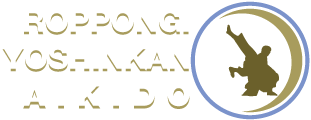Dojo Etiquette
TRADITION, RESPECT, AND DISCIPLINE
One of the most important aspects of the study of Budo is learning to discipline one's own behavior and self control. A prime example of this discipline is the etiquette with our instructors and fellow students as well as in the dojo or practice area. Unfortunately, the etiquette we observe is often confused with worship. Aikido is not a religious practice. When we bow or observe special ceremonies, we do so for the purpose of training our minds and to show respect, not for worship or submission.
Etiquette is also a form of respect. The etiquette we practice shows respect for our instructors and for our fellow students. We show respect by following the correct procedures of dojo etiquette.
To be impolite is to be lacking in consideration of others; to be inconsiderate is to be lacking in some essential kindness. Correct etiquette in Aikido is, basically, acting politely and with consideration of others.
Some of the stylized manners we assume are:
- When entering or leaving a dojo we face the front of the practice area and bow. We use this bow as an opportunity to remind ourselves to be grateful for this place to train.
- We take off our hats and shoes, dispose of chewing gum, and stop any other distracting practices that might interfere with our training or others' training. When we study Aikido we want to focus all our attention and energy on the one task. Visitors are also expected to observe these guidelines for conduct.
- At the dojo, we take off our street clothes and put on a training uniform (a dogi, if possible). This helps us shed our outside concerns and focus our attention on our current task -- Aikido training.
- Complete uniforms are preferred. Our study is a formal one, and the completeness of our dress reflects the attention we give to our study. A complete uniform also affords greater protection of our bodies.
- When we greet a fellow student or an instructor, we greet them with a traditional bow. This is customary in the practice of Japanese Budo. Bowing is also a sign of humility and reminds us that we are unendingly involved in a relationship with the people around us.
- When coming into or leaving the practice mat, we bow again to the front of the dojo. This expresses our intent to concentrate fully on our aikido training, and acts as recognition of all the individuals, past and present, who have contributed to Aikido.
Other points of etiquette:
- All jewelry and watches must be removed before practice.
- Make sure all fingernails and toenails are trimmed short so as not to cause undue injury to others.
- Upon entering the dojo, when you see the instructor, greet him or her by bowing and saying "Osu!"
- Sandals should be lined up neatly at the edge of the mat, not strewn about haphazardly. Shoes must be neatly placed in the shoe rack (when available).
- When class is ready to begin, before the teacher sites, the students line up sitting in seiza in a straight line. The person to your right should be of equal or higher rank; the person to your left, equal or lower rank.
- The highest-ranking students will command "Shomen ni rei." This means "bow to the front" and is a sign of respect to the founder and the traditions of Aikido. The senior student will then say, "Sensei ni rei" which means "bow to the teacher".
- When a technique is being taught, the students kneel quickly. When corrected by the instructor, they bow and say either "Osu!" or "thank you".
- During the class, any student wishing to leave the mat or practice something other than the class is practicing must first ask the permission of the instructor.
- If the dogi becomes disarranged during practice, the student and partner first bow then kneel. Each student straightens his uniform, stands, and bows again before resuming practice.
- Always begin and end your training with your partner by bowing to each other.
- Never shout, curse or become angry on the mat. If there is a disagreement, ask the instructor what is right.
- When the instructor is off the mat, the senior student becomes responsible for the class. Listen to the senior student as you would the instructor.
- When the class is ending, the students quickly line up and kneel, before the instructor sites.
- Students remain kneeling until the instructor has left the mat.
- Students should wait for the class to be dismissed, and then find their partner and bow to him or her, thanking their partner for training with them.
- Other important aspects of etiquette deal with more commonplace concerns. Please remember to pay your dues on time. In our enjoyment of Aikido training, we may forget about our responsibilities to Aikido, and to our instructors. When training as a visitor in another dojo, please check the visitation policies, and remember that your behavior reflects on your home dojo.

